Asian Death Rites
Death is a regular part of everyone's life. We all have to die. We experience deaths of those close to us. Many believe that the death is not the end. Some believe it is the end.
Cultures all over the world have numerous traditions concerning death rites. According to anthropologists, death rites include traditions occurring at the time of death and during burial itself. Death rites include religious beliefs, characteristics of local culture, but also many prejudices.
In Vietnam when some family member is about to die everyone gathers around him/her. These are the moments of silence. The eldest son or daughter bends towards dying person to hear few last words.
Then the eldest member of family suggests a name for the dying person. It is believed that it is unfortunate to keep the name a person used when he/she was alive. Vietnamese men usually get the name "Trung" meaning faithfulness or "True" which means loyalty. Women are usually named "Trinh" meaning devotion or "Thuan" which means harmony.
According to an old Vietnamese tradition after the body is washed and dressed, a chopstick is put between the teeth and then little bit of rice and three coins are placed in the mouth of the deceased.
In the north of Vietnam people are traditionally buried in the piece of land where they used to live. So, it is not strange to see a grave in the middle of a rice paddy. After two years, the family of the deceased will dig out the body remains. They will clean the bones and bury them again in the family garden.
Also in Vietnam there is a belief that some fake money has to be put under a rock close to the grave. This is done to help the deceased in his journey to the next life.
For the people of Cambodia death is only a transition from one to another life. Cambodian Buddhists are usually cremated. Their ashes are kept in a stupa set in the local temple.
Family in grief traditionally puts white flags known as „white crocodile flags“ in front of its house. The wife/husband and children also shave their heads. They are dressed in white. Teeth or parts of bones of the deceased are often worn on chains as amulets.
Ngaben or Cremation Ceremony is a death rite from the Indonesian island of Bali. Social status of the deceased influence the time of its performance. For the people of higher caste it is held within three days after death. For those belonging to lower caste it takes longer. Mass Ngaben ceremonies are quite common.
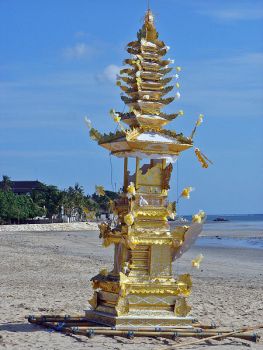 Wadah sarcophagus
Wadah sarcophagus
The exact day of the ceremony is decided by the expert. The ceremony starts by putting the body into a coffin. The coffin is then placed in the sarcophagus. There are two types of sarcophagus. Lembu has shape of a water buffalo. Wadah looks like some sort of temple. Sarcophagus is made of paper and wood.
When everything is ready group of people carries the sarcophagus towards the place of cremation. They do not choose the shortest way. They often change the direction. It is done so to cheat the evil spirits. During cremation sarcophagus is burned. The act sets the sprit free. It enables reincarnation or reaching Moksha. Moksha is a freedom from cycle of reincarnation.
Some 650,000 members of Toraja nation live in the mountains of south Sulawesi island located in Indonesia. The noble Torajas have especially big funerals.
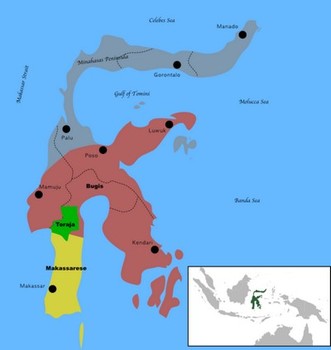 Toraja people (green section) on Sulawesi island
Toraja people (green section) on Sulawesi island
The ceremony is held at the site called "rante" which is usually a grassy field with places for audience, rice barns and structures needed for the ceremony. The ceremony is quite long. It can last from few months up to several years after the death.
For the Torajas death is a process towards "Puya" or "the land of souls". During so called waiting period the body is wrapped in several layers of cloth and kept under the "tongkonan". The tongkonan is a traditional house of Toraja people. It is believed that during the ceremony the soul of the deceased is still present in the village. The journey to Puya starts after the ceremony.
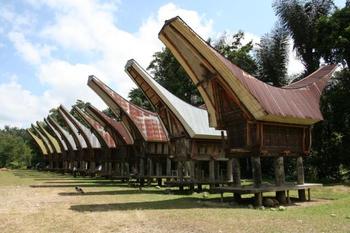 Tongkonan house of Toraja people
Tongkonan house of Toraja people
Very important thing at the funeral is the slaughter of water buffalo (Bubalus bubalis). The number of slaughtered animals depends on how powerful the deceased was in his life.
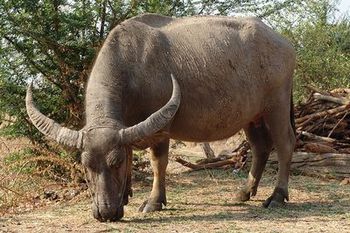 Water buffalo
Water buffalo
The dead animals are usually lined on the rante (ceremonial field) waiting for their owner who is, as the Torajas would say, in the "sleeping stage". They believe that the deceased needs buffalos to reach the Puya faster. More bufallos faster he will travel.
The slaughtering at the funeral is quite an event for the Torajas. Tens of buffalos and hundreds of pigs are slaughtered. Everything is accompanied with lot of music and dancing. Young boys traditionally catch the spurting blood in long bamboo tubes.
Some of the slaughtered animals are given to the people in audience. But every animals given is carefully noted because they are part of the funeral cost which will be paid by the family of the deceased.
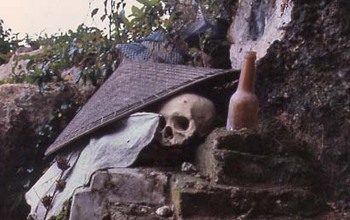 Toraja burial site
Toraja burial site
The body of the deceased is put in coffin and buried. The coffin can be laid in a cave or in a carved stone grave or is hung on a cliff. The coffin also contains things needed in the Puya.
Toraja deceased in a local caveFull body size figures of the deceased or "tau tau" are placed in the cave looking out. Coffins of dead children are usually hung from ropes on a cliff face or from a tree. After several years the ropes used get rotten and coffins fall on the ground.
Abhidharma (in Sanskrit) or Abhidhamma (in Pāli) are ancient (3rd century BC and later) Buddhist scriptures. Four syllables which are believed to be the essence of the Abhidharma are ci, ce, ru, and ni. They symbolize "heart, mental concepts, form and Nibbana (Nirvana)". In Thailand they are written on a piece of paper and put in the mouth of the dying man.
After death the Thai bath the dead body. The ceremony also includes relatives and friends who pour some water over one hand of the deceased.
According to Chinese belief people constructed kites to commemorate dead family members or friends. The Qingming festival (Clear Bright Festival, Ancestors Day or Tomb Sweeping Day) is held on the 104th day after the winter solstice (or the 15th day from the Spring Equinox). In the Gregorian calendar it is around the 5th of April. It is believed that on this day the gate of hell open and people can use kites to send greetings to their loved ones who passed away.
The Hmong people live in parts of China, Vietnam, Thailand and Laos. Their funeral rituals usually start on friday and last until monday when the deceased is buried. The Hmong people believe in the reincarnation. Melody performed with the bamboo flute called “qeej” is supposed to guide the spirit of the dead to its ancestral home.
People also make a boat filled with fake gold. The spiritual journey can not be made without fortune. Animals like cows and chickens were once sacrificed during funeral rituals. The deceased is dressed in black and white clothes. Red and green clothes should not be used as it can make the deceased sick. The deceased also has special shoes. A chicken is often put next to his or her head.
In Nepal if a death occurs in the family shoes made from materials other than leather must be bought for male members of the family. They are forbidden to wear leather shoes for a year. The family is not allowed to use salt for three days. At the end of third day they get a specially anointed salt from the Lamas.
Varanasi (Benares, Banaras) is a city on the left (west) bank of the river Ganges (Ganga) in the Indian state of Uttar Pradesh. The wish of many Hindus is to make their final pilgrimage to die in this city.
It is believed that dying there will help to break the cycle of death and re-birth, and will allow the soul to ascend to "Pitriloka" or the world of the ancestors. Along the river Ganges there are more than 80 funeral pyres. A pyre is a structure, usually made of wood, where dead people are cremated. Sometimes those who are unable to cremate the body of their loved one just throw the body in the river.
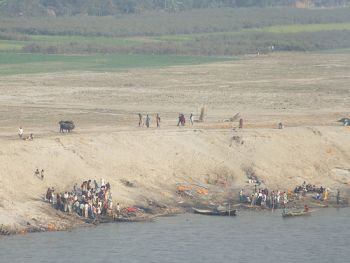 Funeral pyres
Funeral pyres
The Bishnoi is a sect of nature worshippers in the Indian state of Rajasthan. Larger Bishnoi communities also exist in neighbouring states of Uttar Pradesh, Madhya Pradesh and Maharashtra. The Bishnoi people are covering their dead in salt before burying them in unmarked trenches.
The Aghori is yet another Indian Hindu sect. Majority of Hindus condemn them because of their cannibalistic rituals. They eat corpses they get from rivers (including the Ganges river) or at places where bodies are cremated. They believe it is normal as they believe that dead body is just a natural matter which was once alive.
Members of Parsi community in India put their dead on so called "tower of silence". There the body is eaten by vultures.
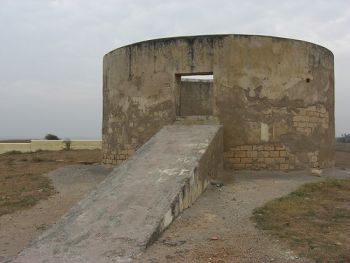 Tower of silence
Tower of silence
The Andaman Islands are a group of some 200 islands in the east of the Bay of Bengal. They belong to the Andaman and Nicobar Islands Union Territory of India.
Local people take body of the deceased out of the grave as soon as it decomposes enough. Some then carry bones to show that they are mourning. You should not approach them and interfere with their grief.
Jewish people never leave the dead body alone. It is done so as a sign of respect. Persons who stay with the body as kind of guards are known as "shomerim". According to Jewish religious laws a person who was with the dead became ritually unclean. That is why the person must wash his hands. It must be done no matter if he touched the deceased or not.
The Ilcano or Ilkano people live in the north of Philippines. They believe that the death of some person can be predicted through symbols seen in dreams. Such symbols are falling teeth, falling hair, falling hat, dreams of floods, snakes and some black animals. The arrival of black butterfly or a moth into the house is an especially bad sign.
The Isneg (Apayo) people live in the Cordillera Administrative Region located on the Philippine island of Luzon. They believe that it is good to bury their deceased under part of their home where they cook.
The Cebu province includes Cebu island and 167 smaller islands. The local people believe that relatives of the deceased should not bath or comb their hair close to the place of funeral.
It is believed that your tears should not fall on the coffin glass. That way the soul could start its journey peacefully. Let's now imagine that the person died from crime. To speed up the catching of the murderer the relatives of the deceased will put a chick on the coffin.
Before moving the coffin to the funeral car all relatives of the deceased should pass under the coffin. That way they will be able to continue their life without the deceased more easily.
People will then walk to the church and after that to the cemetery. This is called "hatod" or "bringing the dead to his destination". Some food is prepared for all who participated in the hatod. The food is given at the cemetery. No food should be brought home. So, if something is left it is given to for example persons working at the cemetery.
Everyone present at the funeral should pass through the smoke of the fire lit at the cemetery or at the cemetery gate. This is done to ward off evil spirits.